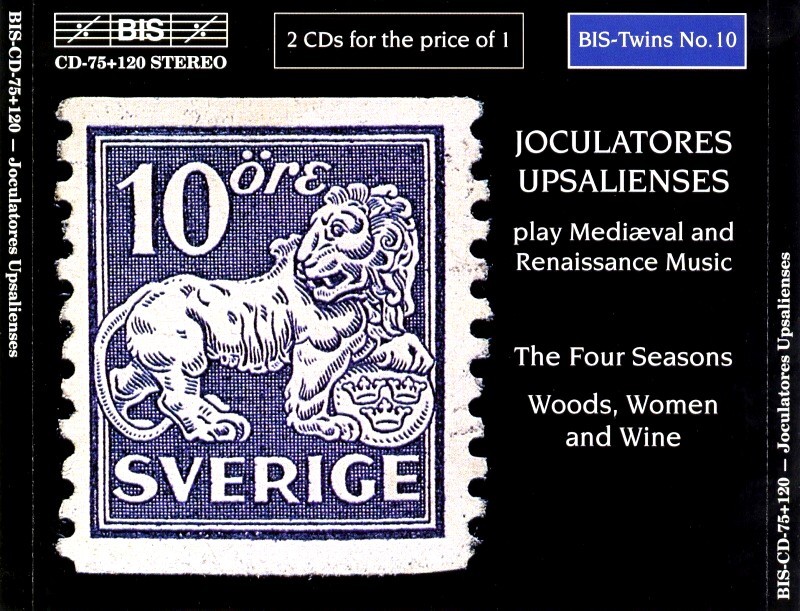

BIS Twins No. 10
BIS CD-75+120
1995
The Four Seasons
Woods, Women and Wine


BIS Twins No. 10
BIS CD-75+120
1995
The Four Seasons
Woods, Women and Wine
Short Glossary of Medieval and Renaissance Instruments
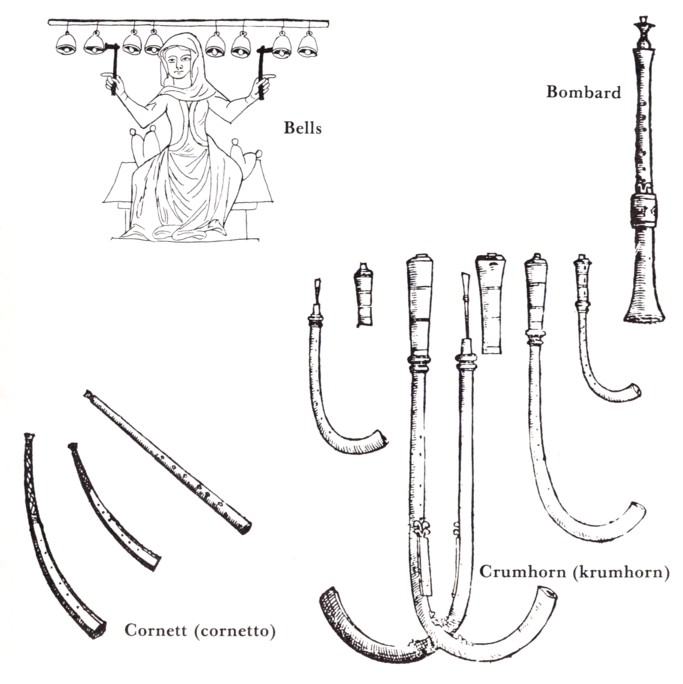 Bells
appear in many medieval illustrations of musical groups, especially
during the period between 1000-1500. The small cast bronze bells, four
to fifteen in number, are usually hung in a horizontal row and struck
with metal hammers by one or two players.
Bells
appear in many medieval illustrations of musical groups, especially
during the period between 1000-1500. The small cast bronze bells, four
to fifteen in number, are usually hung in a horizontal row and struck
with metal hammers by one or two players.
Bombard (shawm) (French Bombarde)
— a straight conical wind instrument with a double-reed, large bell and
a strong sound rich in overtones. The smaller forms can be regarded as
the predecessors of the modern oboe and cor anglais. Around the year
1600 the pommer family had up to seven members, the largest two of which
(bass and contrabass) had lengths of 7 and 10 feet! These instruments
were used exclusively out-of-doors or in large halls.
Cornett (cornetto)
can most easily be described as a gently-bent or straight conical
wooden trumpet with finger-holes. The curved forms were often covered
with black leather unless they were made of solid ivory. The cornett is
related to the Scandinavian folk finger-hole cowhorn and wooden trumpet
and probably developed from similar instruments during the Middle Ages.
The instrument's most important period in concert music was during the
16th and 17th centuries.
Crumhorn (krumhorn) is, like the kortholt,
a windcap instrument and as such related to the bagpipe. Its sound is
pungently nasal and is best suited to chordal music, using perhaps all
the four sizes (soprano, alto, tenor, bass — maybe even the contrabass)
together. Each instrument has a little over an octave's range and a bent
shape (J-shape, German krumm = bent). The crumhorn is known to have
existed at least from the end of the 15th century.
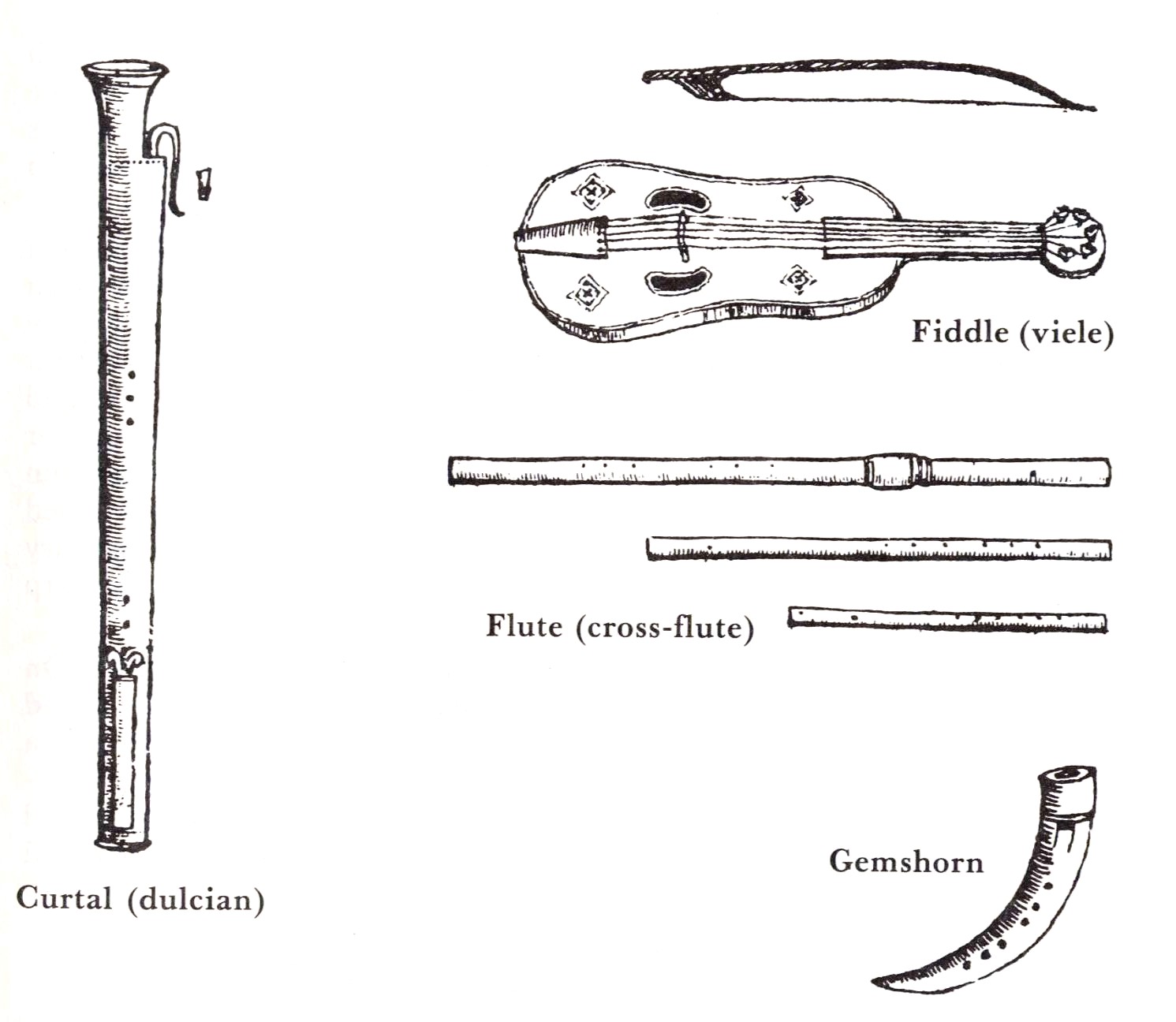 Curtal (dulcian),
a 16th-17th century predecessor of the bassoon, likewise played with a
double-reed. The curtal was also built in several sizes, from soprano to
contrabass. The most important was the bass, which was often used to
support the bass voice of the vocal choir.
Curtal (dulcian),
a 16th-17th century predecessor of the bassoon, likewise played with a
double-reed. The curtal was also built in several sizes, from soprano to
contrabass. The most important was the bass, which was often used to
support the bass voice of the vocal choir.
Fiddle (viele)
can be regarded as a medieval predecessor of the violin. It has a rather
flat soundbox, often without soundpost, and the tuning pegs are
fastened in a solid flat board. The number of strings varied between one
and five. The bow was highly arched. The instrument's sound is rich in
overtones and nasal.
Flute (cross-flute) was, during the
Middle Ages and Renaissance, a simple cylindrical wooden tube with a
mouth-hole and six finger-holes. During the 16th century it became a
family with first three, and then four members (soprano, alto, tenor and
bass). Of these, the soprano is equivalent to our piccolo and the tenor
to our standard flute, in terms of size and pitch.
Gemshorn
is a type of medieval recorder made of horn. It is blown at its wide
end, into which a wooden block is inserted forming a recorder-type
mouthpiece. The instrument, again like the recorder, has a number of
finger-holes. Its tone is mild but clear and distinct. The gemshorn was
probably first a shepherd's instrument, and is regarded to have
flourished during the 15th century.
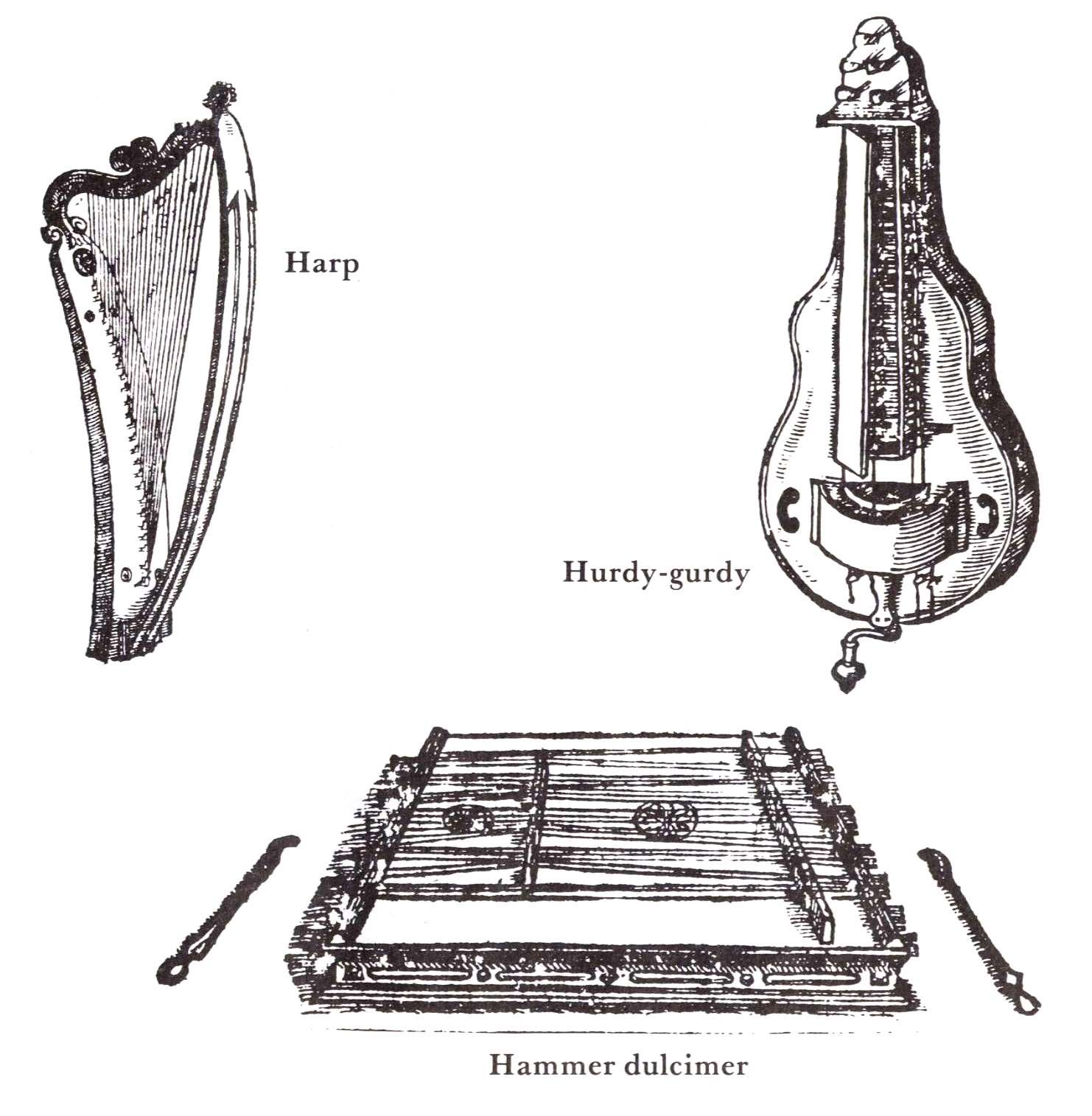 Hammer dulcimer — a
type of zither, the strings of which are struck by small hammers which
are held directly in the player's hands. It can, therefore, be regarded
as a predecessor of the piano, the hammer mechanism of which is
activated by keys. The hammer dulcimer is still encountered as a folk
instrument in England and Switzerland, and as the cimbalom in the Balkan
countries.
Hammer dulcimer — a
type of zither, the strings of which are struck by small hammers which
are held directly in the player's hands. It can, therefore, be regarded
as a predecessor of the piano, the hammer mechanism of which is
activated by keys. The hammer dulcimer is still encountered as a folk
instrument in England and Switzerland, and as the cimbalom in the Balkan
countries.
Harp, an extremely old type of instrument,
depicted already in the ancient civilisations. How the instrument
reached Europe is unclear, but we come across it in pictures as early as
the 9th century. At a very early period the harp was used by
Scandinavians and Celts as an accompanying instrument for bardic epics,
and it later fulfilled a similar function in the music of the
troubadours, trouvères and minnesingers. In polyphonic music it became
an important instrument in quieter types of ensemble (musica bassa).
The harp of the 13th and 14th centuries had from one to two dozen
strings of gut or metal, which in all probability were tuned
diatonically. The instrument was not played with a plectrum like
contemporary lutes and psalteries, but with a finger technique, for
which, however, long sharp nails were apparently sometimes recommended.
Hurdy-gurdy
is a medieval instrument, related to the Swedish keyed fiddle. On both
of these the melody string produces a scale with the help a row of keys,
and there is a series of open drone strings. The latter uses a bow, and
the former a rosined wooden wheel turned by a crank, to set the strings
in motion. The hurdy-gurdy arrived in Europe during the 12th century,
possible via Moorish Spain, and appeared at this time in the royal
courts. It lost, however, its social prestige and was often regarded as a
typical beggar's instrument.
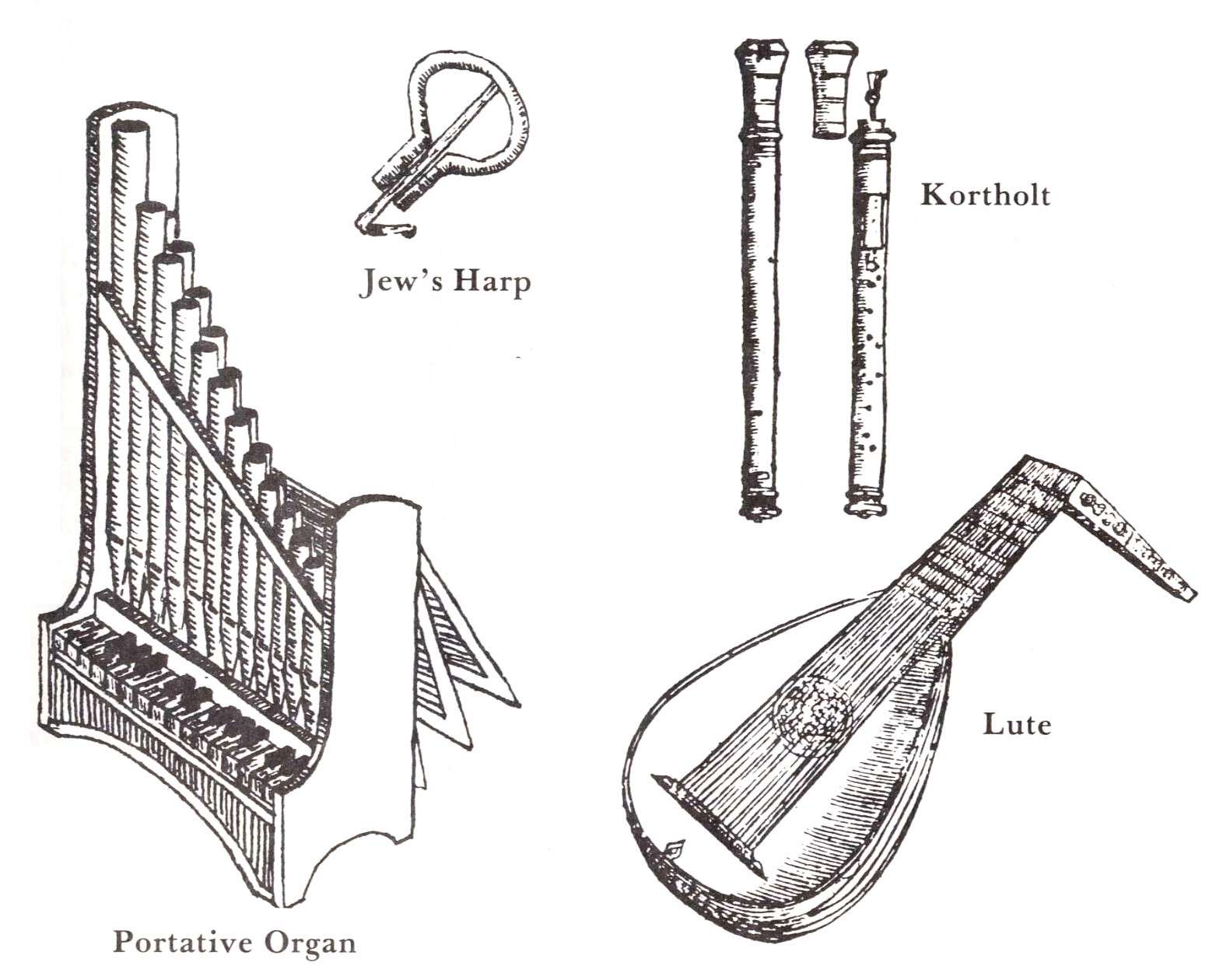 Jew's Harp is a small
instrument of simple construction, consisting of a metal frame, in the
middle of which a bent steel tongue is fastened and can vibrate when
plucked on its free end. This vibrating tongue passes between the arms
of the frame and produces a sound which is amplified when the arms of
the frame are placed in contact with the upper and lower front teeth and
the oral cavity serves as a resonating chamber. By varying the size of
this chamber, as when whistling, different tones can be produced. The
instrument, in different forms and materials, is encountered all over
the world and is believed to have come to Europe from Asia during the
Middle Ages. It was carried from country to country by the wandering
musicians (minstrels, jesters) for whom it was, next to the human voice,
certainly the most portable of instruments.
Jew's Harp is a small
instrument of simple construction, consisting of a metal frame, in the
middle of which a bent steel tongue is fastened and can vibrate when
plucked on its free end. This vibrating tongue passes between the arms
of the frame and produces a sound which is amplified when the arms of
the frame are placed in contact with the upper and lower front teeth and
the oral cavity serves as a resonating chamber. By varying the size of
this chamber, as when whistling, different tones can be produced. The
instrument, in different forms and materials, is encountered all over
the world and is believed to have come to Europe from Asia during the
Middle Ages. It was carried from country to country by the wandering
musicians (minstrels, jesters) for whom it was, next to the human voice,
certainly the most portable of instruments.
Kortholt (German kurzes Holz
= short piece of wood) — has two parallel bores connecting at the
instrument's lower end (U-shape) which gives even the smaller members of
this family a surprisingly low pitch. The tone is formed by a
double-reed which is located inside a capsule. Its tone is nasal and
buzzing, but milder than that of the crumhorn.
Lute — derived from the Arabic al ûd
(= wood), is one of the many musical instruments which came to Europe
during the Middle Ages under the Arabic-Islamic cultural influence. Up
to the 15th century the lute had only four double-strings and was played
largely monodically with a plectrum. A polyphonic finger technique was
developed and its number of strings increased. A typical Renaissance
lute had at least eleven strings: five unison or octave pairs and a
single chanterelle, the highest melody string. The lute had the
same rôle as a social instrument in the late 16th and 17th centuries
that the piano had during the 19th and 20th. Its literature, in both
quality and quantity, can also be compared to that of the piano. Lute
music was generally notated in tablature (hand position notation) which,
by virtue of the instrument's similar tunings, is often directly
playable on the guitar.
Portative Organ — a small portable
medieval pipe organ (sometimes called "organetto"). It could be played
held upon the knee or strapped around the player's back resting on his
stomach (for use, for example, in processions). The keyboard is
perpendicular to the player's body and was played with the right hand
while the left hand operated the bellows. It was usually used
monophonically.
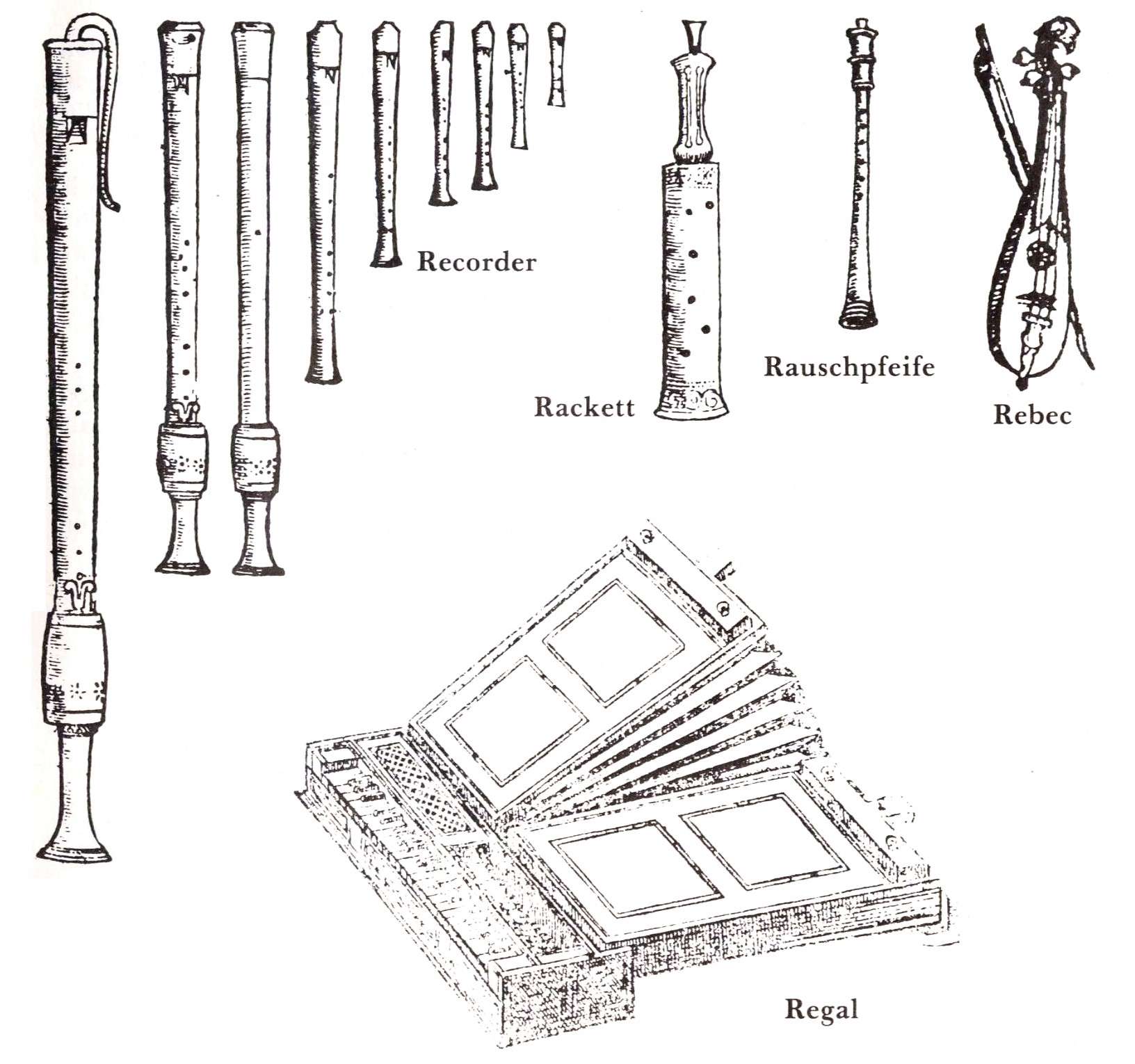 Rackett (rankett) — a small, stumpy
original wind instrument; one of the more curious of the 16th century's
experiments with musical instruments. Several parallel canals are bored
through the length of a small wooden cylinder. These are joined
alternately at the top and bottom to form a single long sounding pipe. A
1' high rackett can, therefore, have an 8' long effective length and
produce tones from as low as the 16' octave! The sound is generated with
a double reed, and is full but soft. (The baroque rackett had a conical
bore and a stronger, more bassoon-like sound. In Germany it was called
"Wurstfagott" — "sausage bassoon".)
Rackett (rankett) — a small, stumpy
original wind instrument; one of the more curious of the 16th century's
experiments with musical instruments. Several parallel canals are bored
through the length of a small wooden cylinder. These are joined
alternately at the top and bottom to form a single long sounding pipe. A
1' high rackett can, therefore, have an 8' long effective length and
produce tones from as low as the 16' octave! The sound is generated with
a double reed, and is full but soft. (The baroque rackett had a conical
bore and a stronger, more bassoon-like sound. In Germany it was called
"Wurstfagott" — "sausage bassoon".)
Rauschpfeife — a reed
instrument with a windcap. As opposed to the kortholt and crumhorn, it
has a conical bore giving it a higher, more strident sound, reminiscent
of Western Europe's folk bagpipes.
Rebec, next to the
fiddle the most important bowed instrument in the Middle Ages. Unlike
the fiddle the bottom of its sound-box has a rounded shape, which is
extended into the neck ("half pear-shape"). Around 1500 the rebec was
built in three sizes (polnische Geigen). As the dance master's instrument the small rebec was still in use in the baroque era, called kit or pochette ("pocket violin").
Recorder,
an instrument with an ancient background. Between the early 16th and
17th centuries its family grew from four members (soprano, alto, tenor,
bass) to eight or nine, ranging from the ca. 7' long contrabass to the
ca. 4" exilent (German Gar klein Flötlein).
Regal —
a small table organ having only reed-pipes. While one person plays on
the keyboard, a second manipulates the two bellows. The tone is very
nasal, being reminiscent of that of the krumhorn family. The regal
traces back to at least the middle of the 15th century and was a popular
instrument for accompaniment during the 16th and 17th centuries.
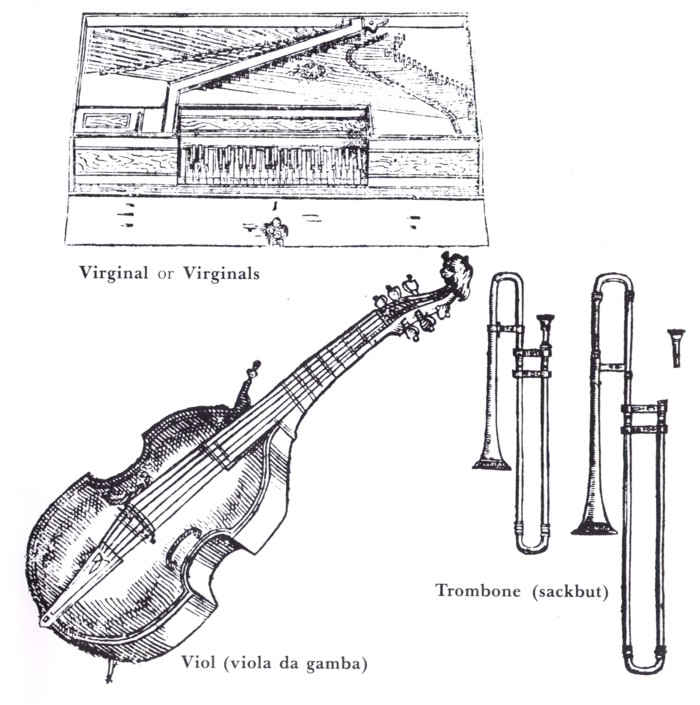 Trombone (sackbut)
with its double slide is regarded as a 15th century invention. The
instrument has remained virtually unchanged to this day. During the 16th
century the sackbut family grew to as many as five different-sized
members. The middle size, the tenor, is most common today.
Trombone (sackbut)
with its double slide is regarded as a 15th century invention. The
instrument has remained virtually unchanged to this day. During the 16th
century the sackbut family grew to as many as five different-sized
members. The middle size, the tenor, is most common today.
Viol (viola da gamba) (leg-viol)
emerged during the 15th century and rapidly became a beloved instrument
at the courts and among the bourgeoisie. In the 16th century the viol
appeared in 4-5 sizes, all of which were played in a vertical position
on, or between, the legs. The viol usually has six strings tuned like a
lute, and a fretted finger-board. The thin strings produce a delicate
sound well suited to consort playing.
Virginal or Virginals
— a member of the harpsichord family, that is: a stringed instrument
with a plucking action and a keyboard. The term virginal is usually
reserved for instruments of small compass, oblong in shape, the keyboard
on the longer side, and having a single register. It is likely that
instruments of this type came into use around 1400 at the earliest and
may be regarded as a development and mechanisation of the medieval
psaltery plucked with a plectrum by hand.